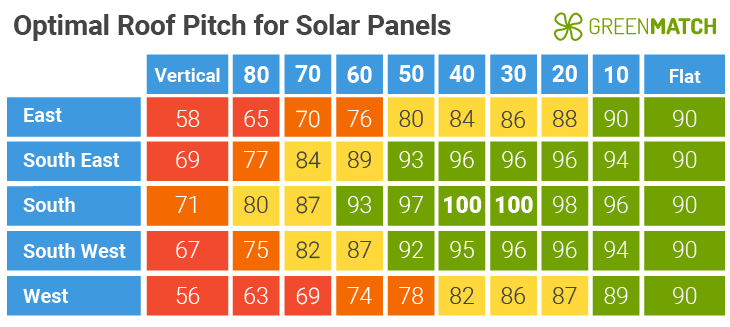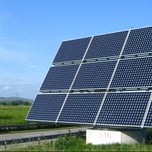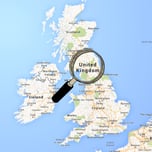
Get up to 4 quotes by filling in only 1 quick form

Slash your energy bills by installing solar panels

We’ve helped over 500,000 homeowners reduce their carbon footprint
- GreenMatch
- Solar Energy
- Solar Panels
- Flat Roof Solar Panels
Solar Panels on Flat Roof – Complete Guide!

Is It Possible to Use Solar Panels on a Flat Roof?
There is an unprecedented trend towards using solar panels in the UK, and many families want to know how they can go solar.
One of the most common questions they ask is whether it’s possible to install solar panels on flat roofs. In fact, flat roofs have now become really common in modern British buildings, while the traditional roof pitch was around 40°-50° in the past.
If you’re one of those families who live in a flat-roof building, our answer to your question is a big YES. In this article, we’re going to let you know some details about installing solar panels on your roof, especially flat roofs.
If you have a flat roof and are ready to install a solar panel system, getting quotes is the first step. At GreenMatch, we can help you find the best quotes from trusted installers in your area. Simply fill in our 1-minute form and you will receive up to 3 free and non-binding quotes. Our service is quick and easy, and we ensure that you get the best deal for your solar panel installation.
- Quotes from local engineers
- Payment by finance available
- Save up to £729 per year
It only takes 30 seconds



Different Roof Pitches for Installing Solar Panels
First, it’s good to look at the best roof pitches for installing solar panels to know the pros and cons of each one.
Flat Roofs
As said earlier, flat roofs are among the most common roof pitches in the UK. Installing solar panels on flat roofs has several pros and cons, and fortunately, the advantages outweigh the drawbacks.
Here is why:
Advantages of Flat Roofs for Installing Solar Panels
These are several advantages of installing solar panels on flat roofs:
- Using less material per square foot and being more cost-effective
- Simple and fast installation process
- Less exposure from the street
- Easier maintenance
Disadvantages of Flat Roofs for Installing Solar Panels
There are also some crucial matters that you need to consider when installing solar panels on your flat roof.
For example, standing water can be a threat and destroy your fixtures sooner, especially if you use poor drainage. Therefore, it’s necessary to work with a seasoned technician to make sure you won’t face any issues in the future.
Low-Sloped Roofs
Low-sloped roofs are also common in the UK and can be used to install solar panels. Here are some advantages and disadvantages of these roofs.
Advantages of Low-Sloped Roofs
- Less roofing materials per square feet
- Easier and safer installation and repair processes
- Better drainage
Disadvantages of Low-Sloped Roofs
- Longer melting process in case you have heavy snow, and as a result, more pressure on fixtures.
- Building codes of your region in the UK must be strictly followed.
Pitched Roofs
Pitched roofs still exist in the UK and have some pros and cons when it comes to installing solar panels.
Advantages of Pitched Roofs
The slope brings about better run-off for debris, water, and snow. Lower probability of water buildup, which can lead to leaks and mould damage.
Disadvantages of Pitched Roofs
Because of the slope, installing, maintenance, and repair are more challenging and may be less safe and more expensive.
What Roof Material Is Best for Solar Panels?
Solar panels may be installed on almost all types of roof, including:
Metal Roof
Metal roofs have several advantages. For example, they are both environmentally friendly and durable.
Also, the solar array is easily attached thanks to the standing seams, and as a result, the installation process is so easy. This way, the labour cost will be relatively lower and it’s a good option for people with a limited budget.
Overall, standing seam metal roofs are the best type of roof for installing solar panels.
Tile Roof
Tiles are produced from a variety of materials such as metal, ceramic, concrete, bituminous, polymer-sand, composite, and stone.
Tar and Gravel
This option is one of the most traditional roof types out there. They are placed on the roof by alternating layers of asphalt or tar and certain supporting elements.
They increase the weight of your structures and make the maintenance process more difficult. Also, it might require more bracing and other materials for installing solar panels.
Other types of materials like Torch Down Roof, Foam, and Wood can also be used when installing solar panels.
Is Planning Permission Needed for Installing Flat-Roof Solar Panels?
Another question homeowners ask is if planning permission is required for installing solar panels on their roofs.
Fortunately, solar panels installation is usually categorized as “permitted development“, which means planning permission is not mandatory for most buildings.
General Criteria for Installing Solar Panels
- Minimal impact on the external appearance of the building and the amenity of the area.
- Equipment should be immediately removed when you don’t need them any longer.
- You can’t install solar panels higher than the highest part of your building’s roof (excluding the chimney).
- Solar panels shouldn’t protrude more than 0.2 meters beyond your roof slope plane.
When Is Planning Permission Needed?
There are some situations in which you need planning permission.
Flat Roofs
You’ll need planning permission if you want to put solar panels on a flat roof. As you know, solar panels on a flat roof are put in frames to provide an angle towards the sun. This usually necessitates a protrusion of more than 0.2 meters above the roof slope, which is against the “permitted development” rules.
Listed Buildings
Solar panels can be installed on listed buildings, although permission is necessary for any change that might impact the building characteristics as an important historical site.
Conservation Areas
If you’re living in a conservation area, you need to become familiar with certain restrictions. Solar PV installation is permitted if only it’s not visible from any public roadways. To know more details about solar panel planning permission, you can go through the website of Planning Portal.
Otherwise, a professional solar panel installer can help you navigate the planning permissions process. At GreenMatch, we can help you get tailored advice and quotes from professional solar installers in your area.
Just fill out a quick form, and we’ll provide you with up to 3 tailored quotes from trusted local installers. Don’t wait any longer, start saving money and reduce your carbon footprint today.
- Quotes from local engineers
- Payment by finance available
- Save up to £729 per year
It only takes 30 seconds



Tips for Installing Solar Panels on a Flat Roof
Now that you know the possibility of installing solar PV systems on your roof, it’s time to learn some more details about the installation. Remember that the more accurate plan you choose and implement, the more comfortable you’ll be in the future.
Here are several tips in this regard:
Consider the Cost of Installing Solar Panels on a Flat Roof
Putting solar panels on a flat roof in different regions of the UK typically costs between £750 and £900 per kW. This is significantly less than the £1,250 per kW cost of installing PV panels of the same size on a sloped roof.
Moreover, the cost of installing solar panels might be different based on a variety of factors, such as the number of PV panels and the mounting method you choose. The point is that the labour cost in flat roof solar panels is considerably low when compared with other types of roofs. Overall, the labour cost will not exceed 10% of the total price of a solar panel system. Look out for solar panel grants in your area as they can help reduce the cost.
The best angle for solar panels in the UK
The best angle for solar panels in the UK is between 30º and 40º in which solar panels have a higher chance of absorbing the sunlight. Although they are very efficient between 20º and 50º too.
And according to a study by Stanford University, the optimal angle for solar panels in the UK is 34 degrees, facing south.
If your roof is not facing south, you can still install solar panels, but they may not be as efficient. You can consult with a solar installer to determine the best angle and placement for your solar panels.

Pay Attention to the Way Solar Panels Are Fixed on Your Flat Roof
As mentioned earlier, you need to be careful about the way installers fix PV panels on your flat roof.
If your roof is not facing south, you can still install solar panels, but they may not be as efficient. You can consult with a solar installer to determine the best angle and placement for your solar panels.
On steep rooftops, solar panels are generally installed using a “penetration mount,” which involves drilling several holes in the roof to secure the racking that supports the solar panels.
But flat roof solar panel mounting systems are a bit different. On flat roofs, weighted mounting systems or “ballast systems” are common. In such systems, the installation process is done without the need for any holes.
In fact, a flat roof solar panel mounting system sits above your roof using gravity, and this makes the installer’s job really straightforward. You can also go for the Bauder roof system, also known as BauderSOLAR, which is a great solution for flat roofs.
It combines the solar PV module and the substructure into a single unit that is fastened to the roof without needing to penetrate the waterproofing of the roof deck.
This guarantees that the roof’s integrity is maintained in the installation process. Moreover, it’s extremely light, weighing between 9 and 12.5 kilograms per square meter, depending on the module you’re using.

We know that finding the right solar panel supplier might mean investing a lot of time to do research. We want to make this process simpler for you, by providing you with up to 3 quotes from different suppliers in your area. This service is completely free for you and is non-binding.
All you need to do is fill in the contact form at the top of the page. We will then get back to you as soon as possible to ask you some further questions, and will then connect you with the most suitable installers. You can rest assured that you get the best quotes on solar panels!
- Quotes from local engineers
- Payment by finance available
- Save up to £729 per year
It only takes 30 seconds




Hossein Karami Lakeh is an engineer interested in different aspects of energy, especially renewable energy technologies. He holds a master’s degree in mechanical engineering, focusing on thermo-photovoltaic systems. He has written several articles for valid ISI journals, international conferences, and high-authority websites to share his ideas on how to make the world a better place to live.
 We strive to connect our customers with the right product and supplier. Would you like to be part of GreenMatch?
We strive to connect our customers with the right product and supplier. Would you like to be part of GreenMatch? 



